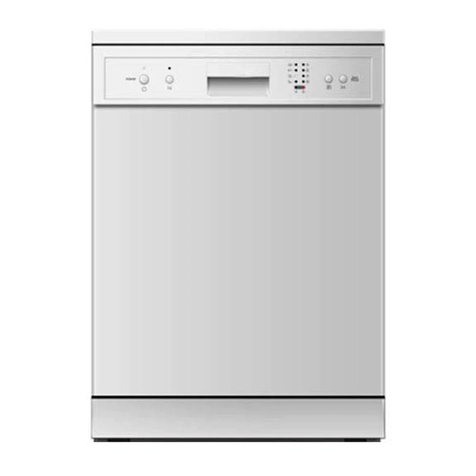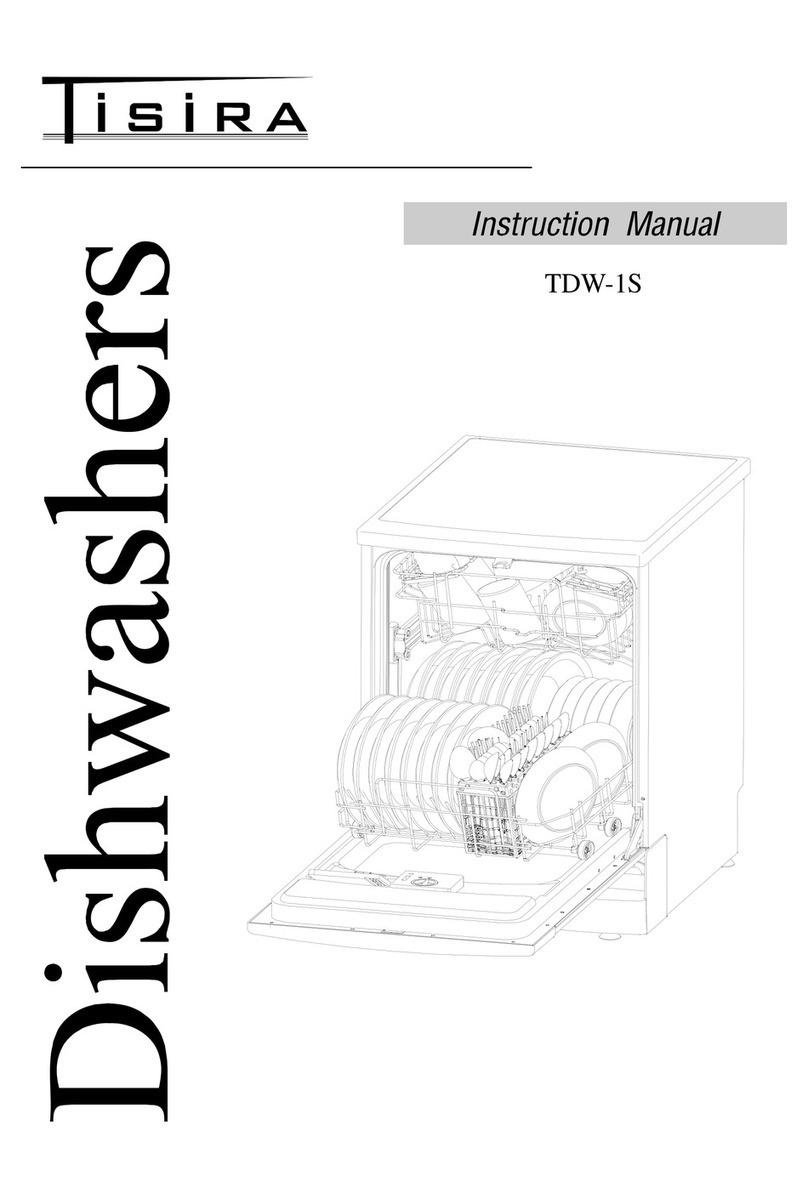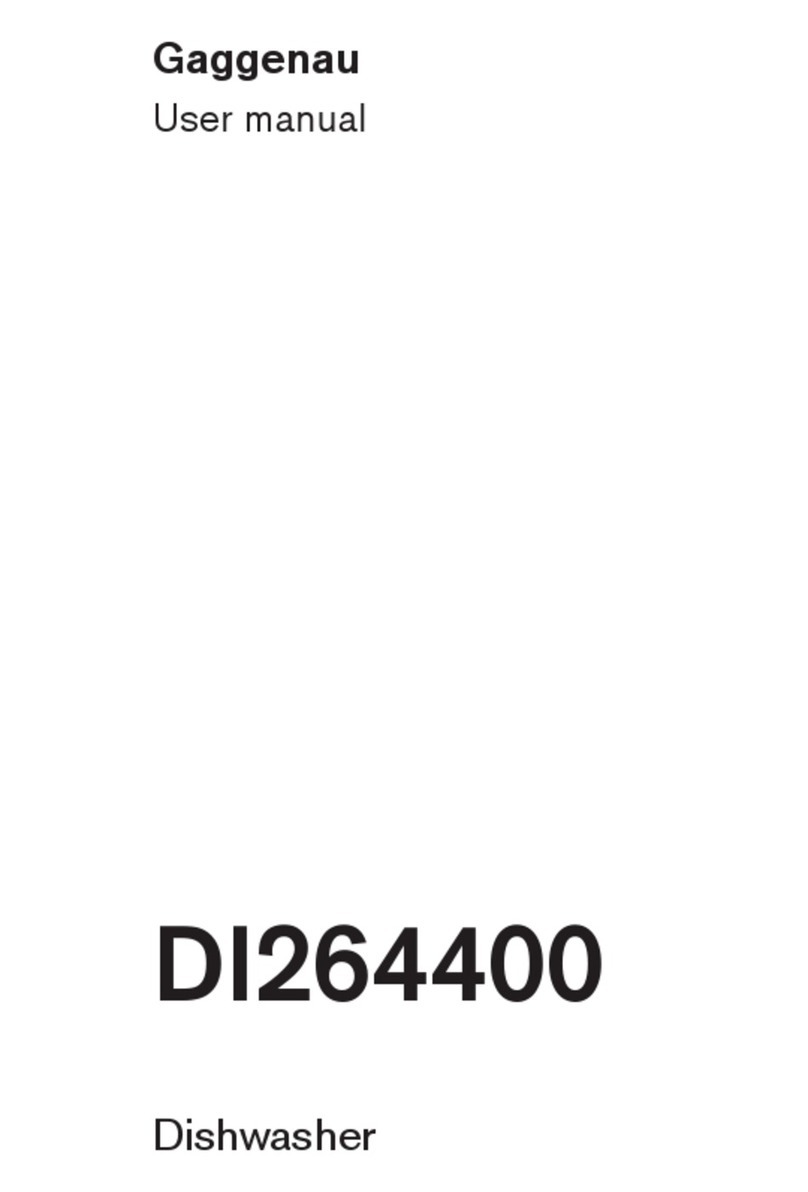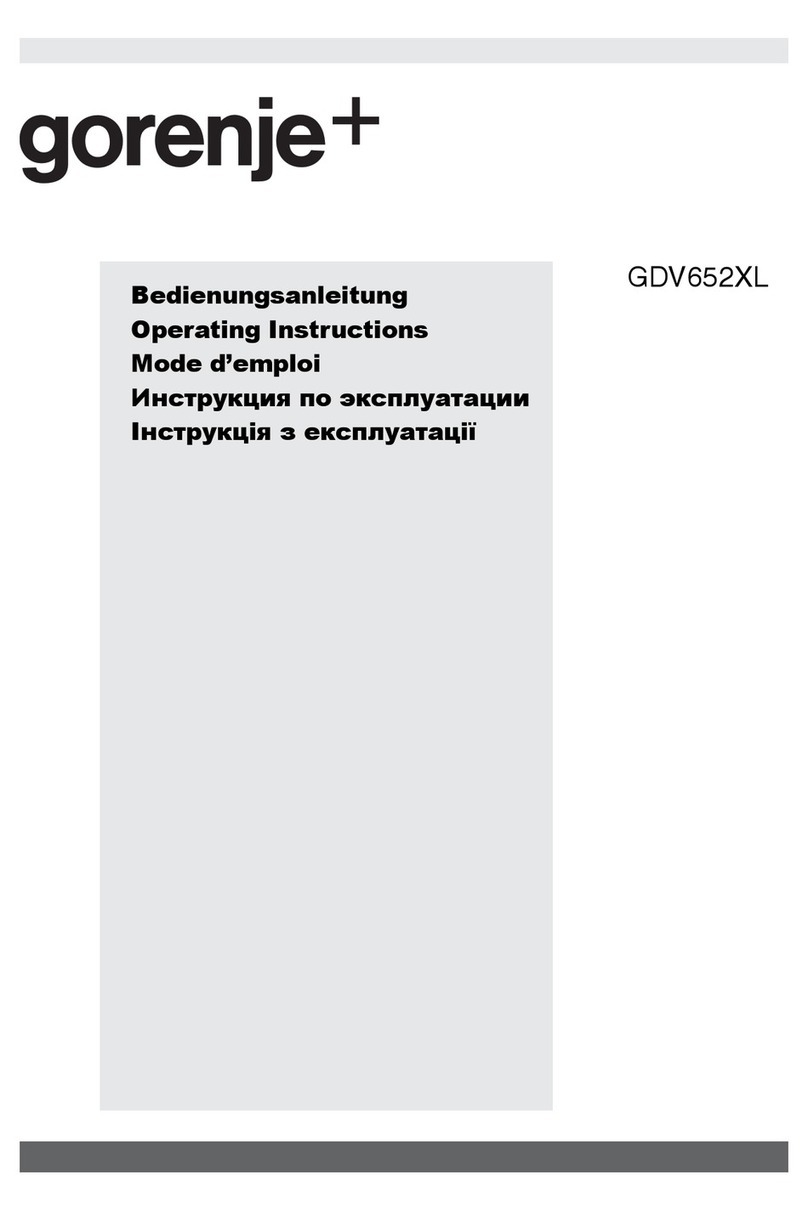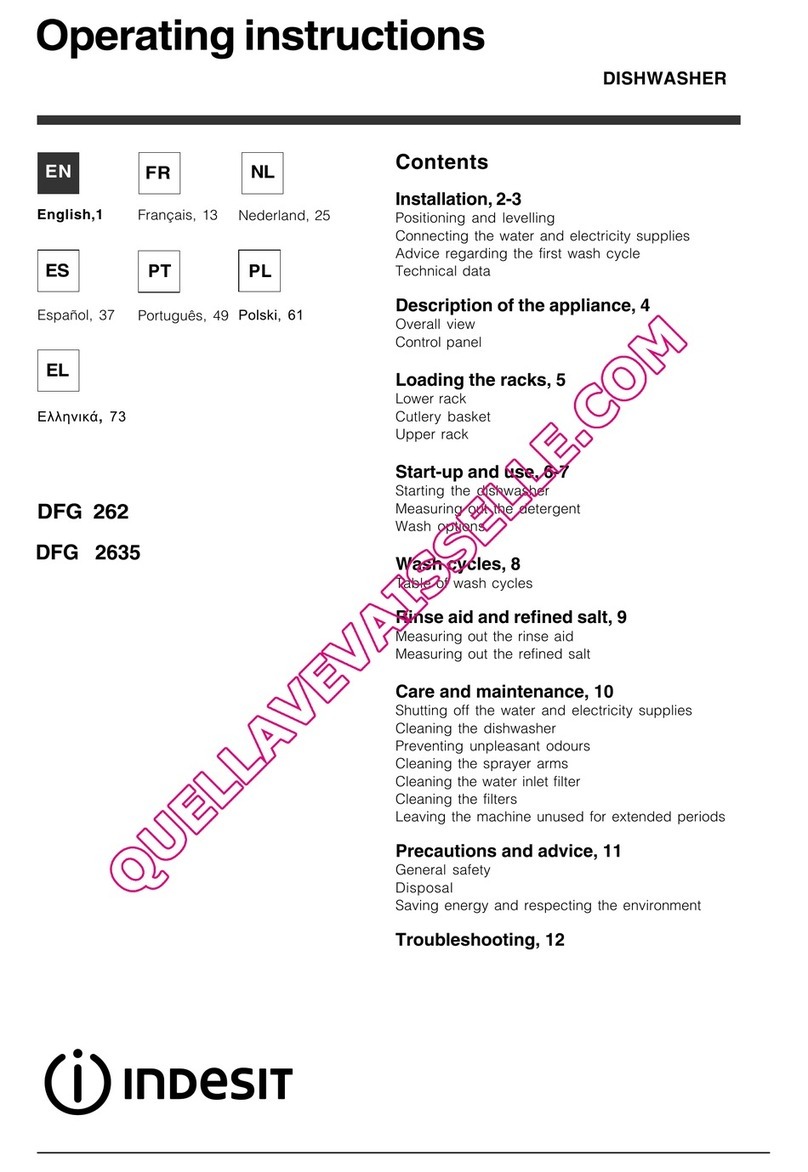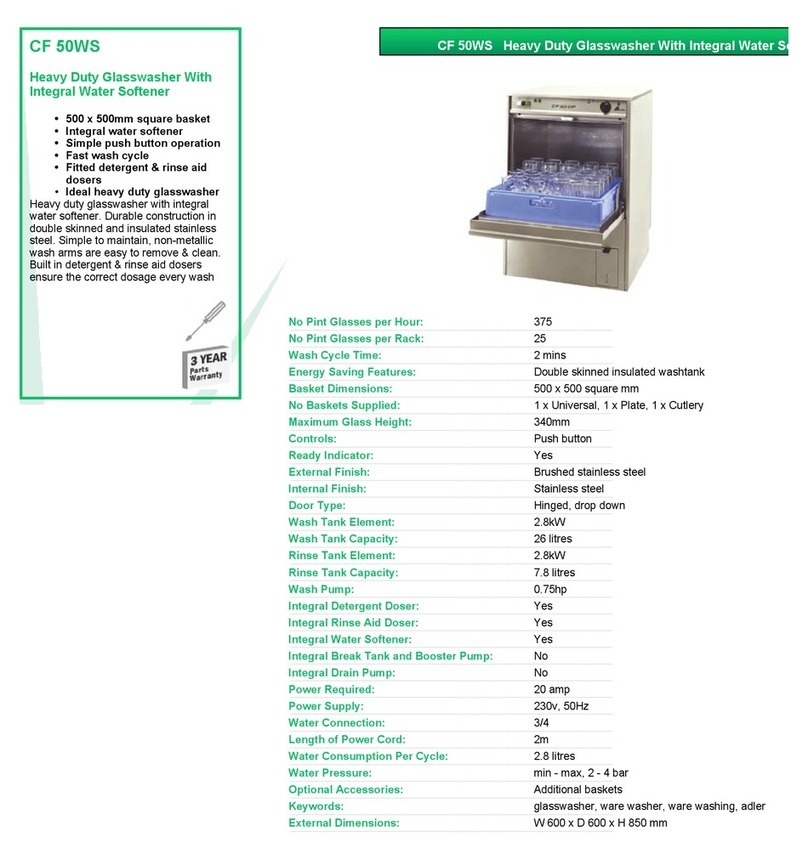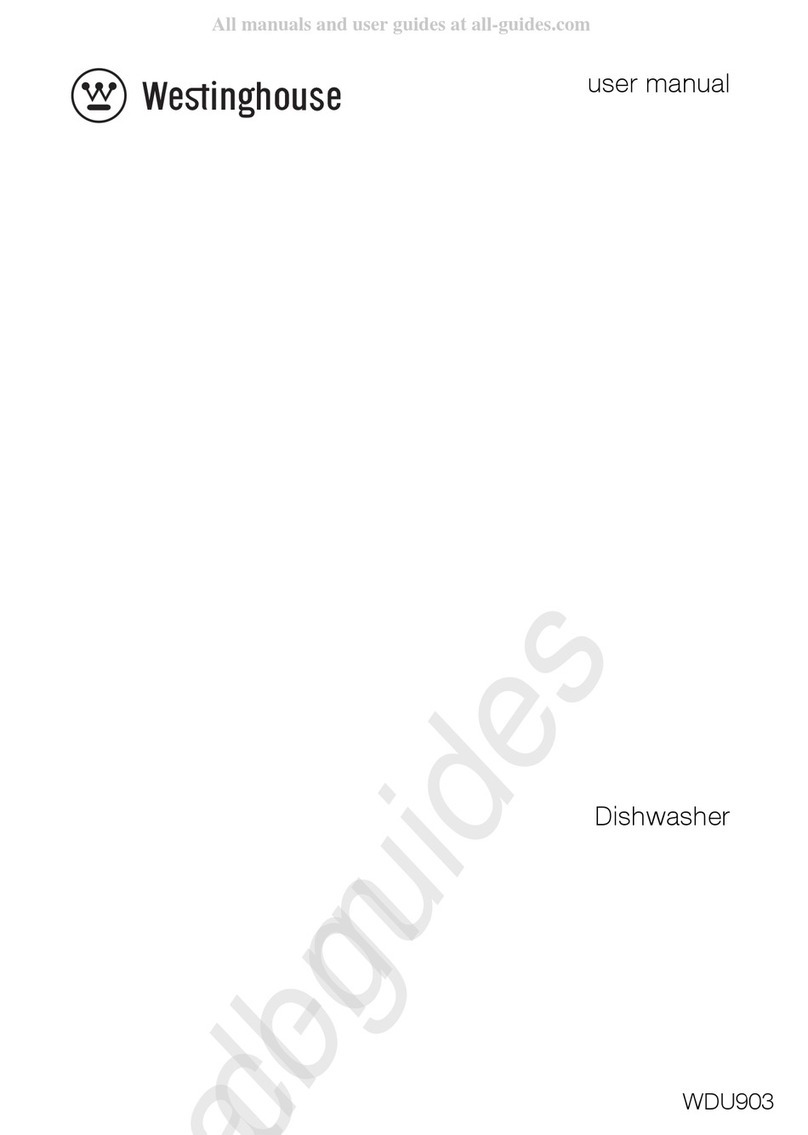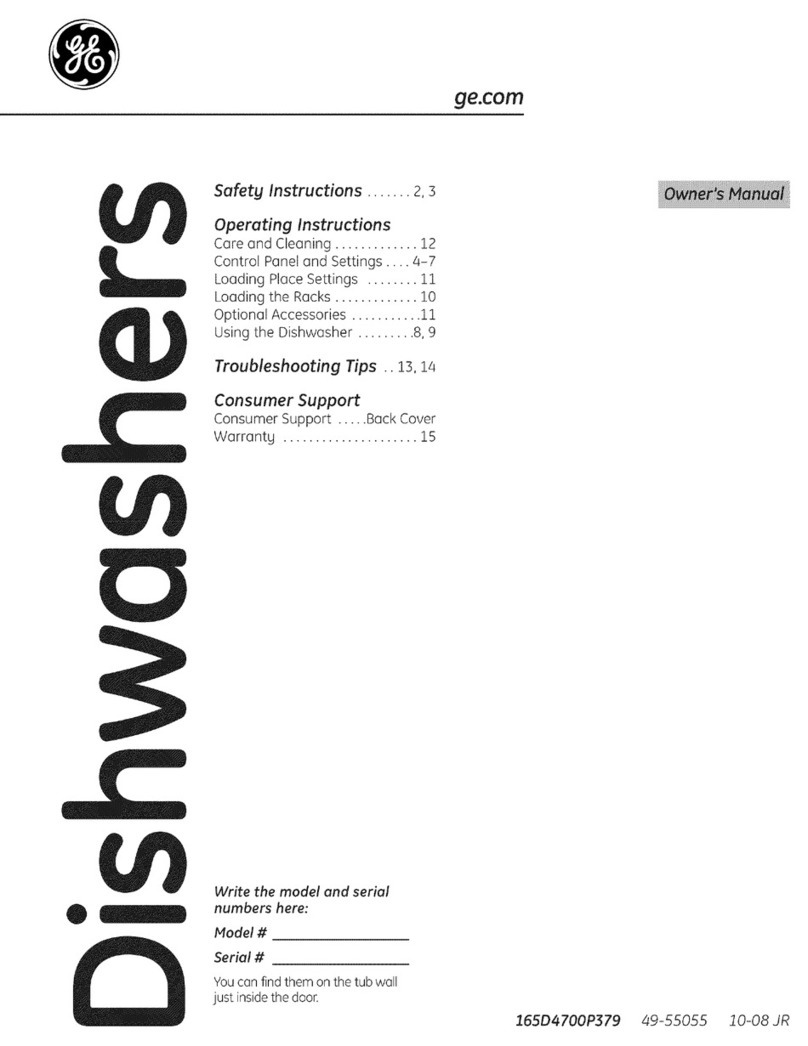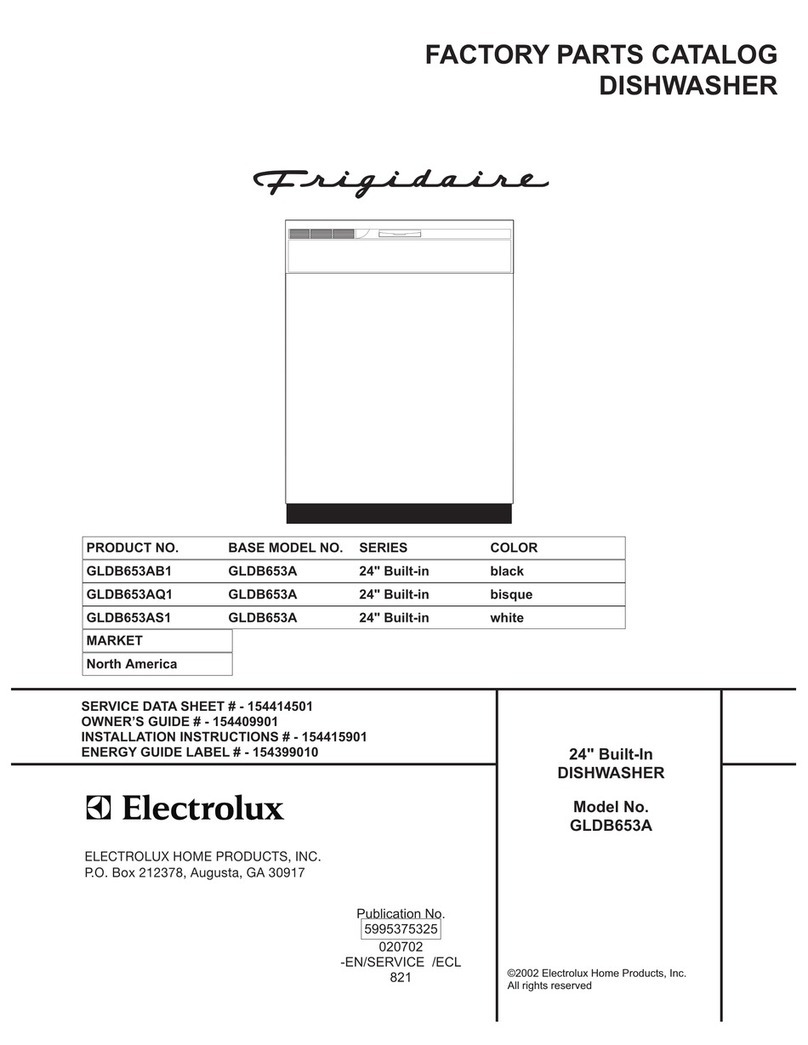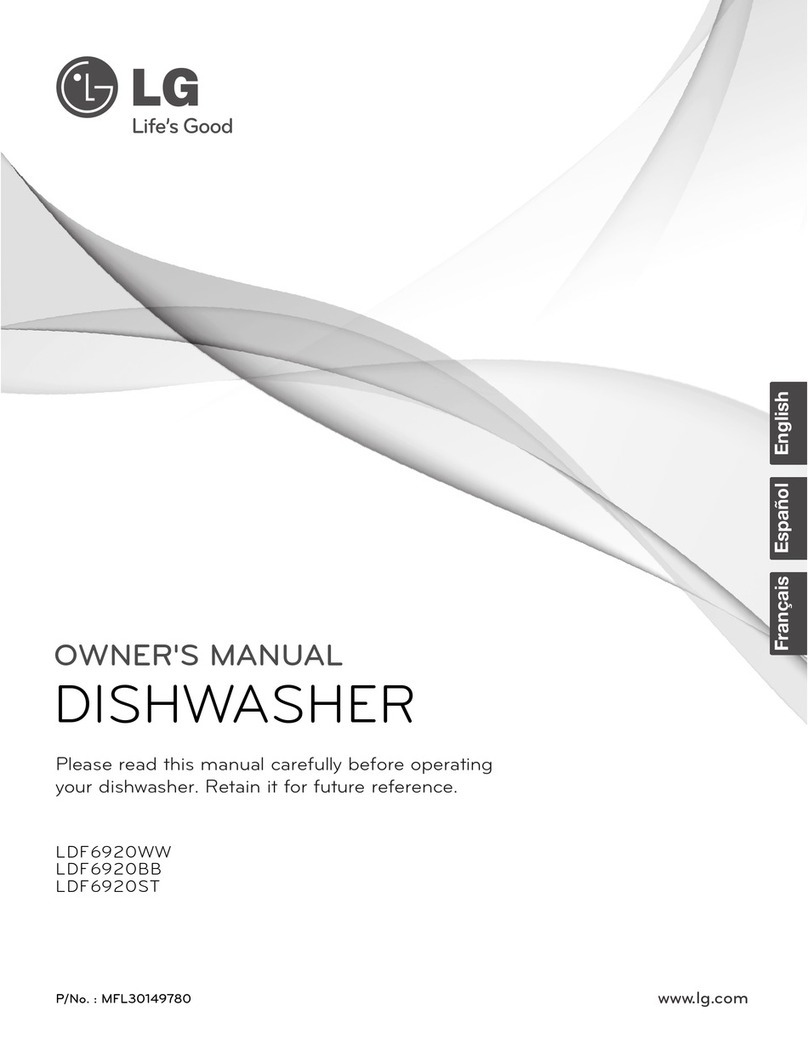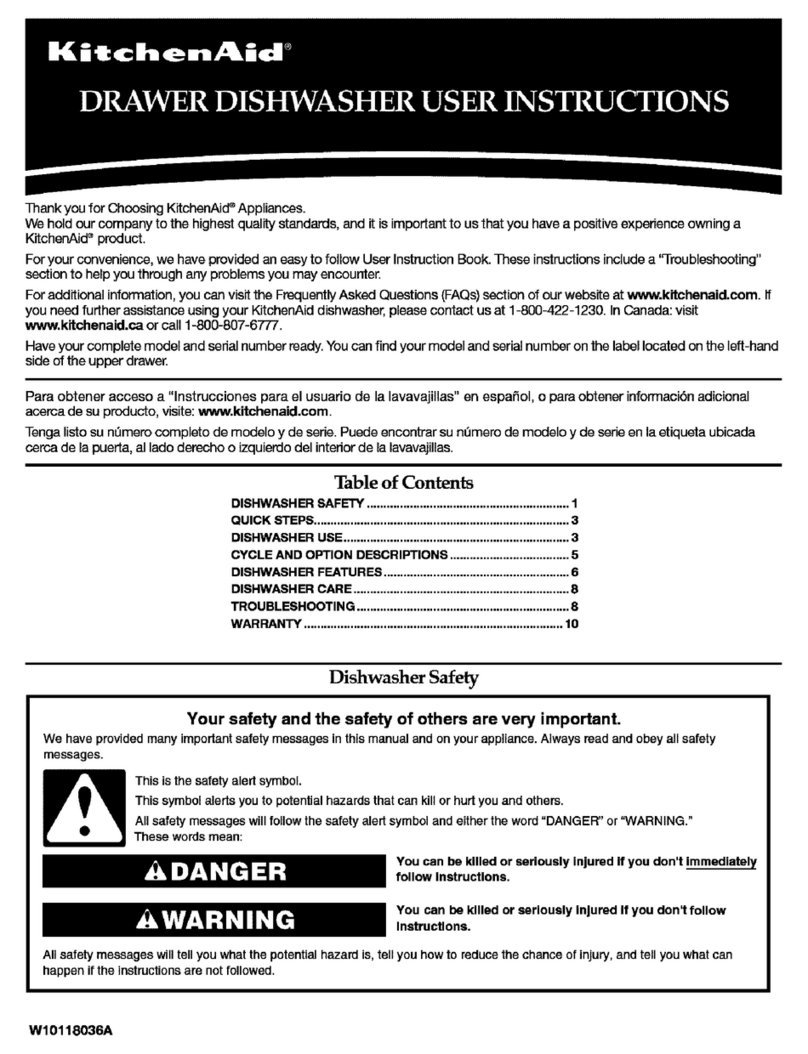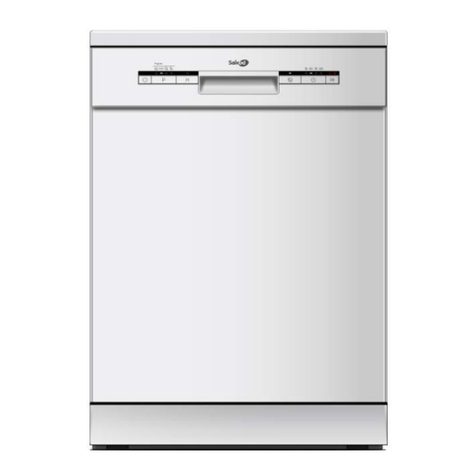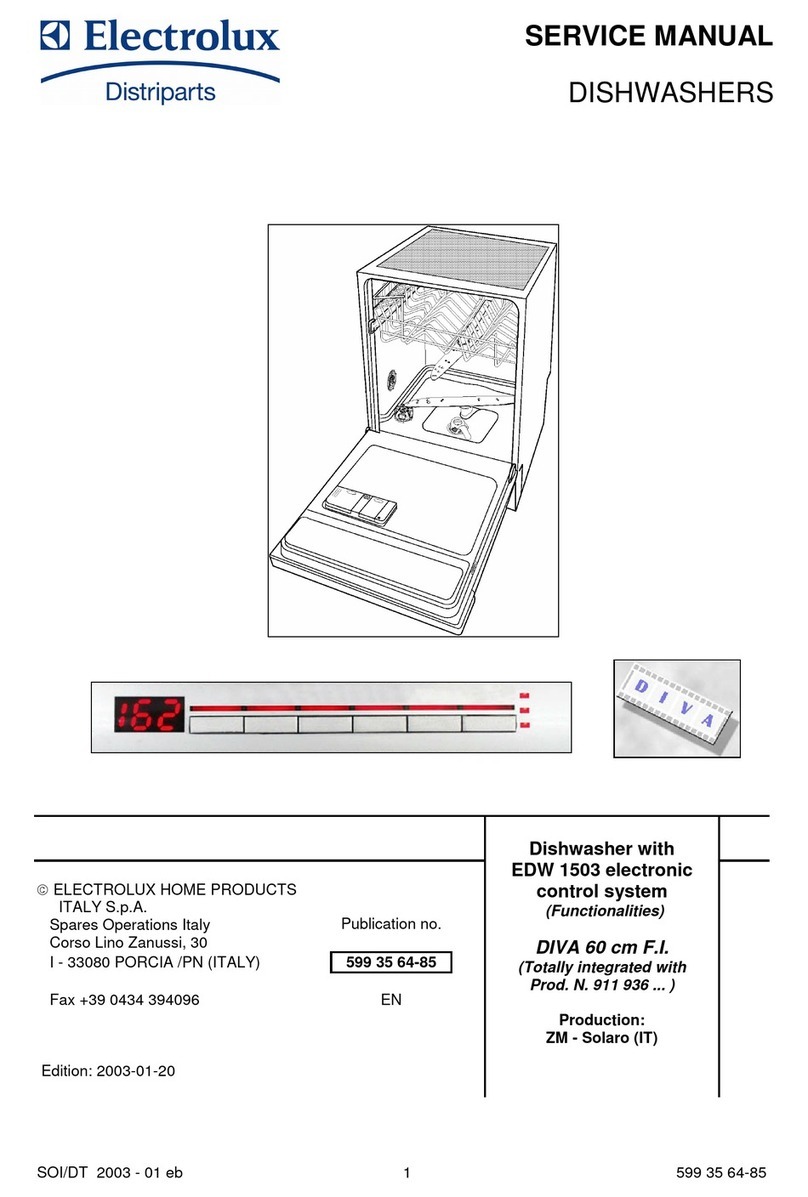Tisira TDW6SS User manual

USER MANUAL
6 PLACE DISHWASHER
TDW6SS
IMPORTANT // Please ensure that you read through this user manual prior to installation and use. This
manual contains important information to ensure optimal performance and keep you safe. Please retain your
proof of purchase, as this will be required in the event that you require warranty service. Remember to retain
this manual for future reference.
www.tisira.com

CONGRATULATIONS ON THE SELECTION OF THIS TISIRA APPLIANCE.
Please read through this user manual carefully as it contains information that
will ensure that your appliance is installed correctly, important operating and
care instructions and also some advice of what you need to do if this appliance
is not performing as intended.
HELLO
To review the section on Troubleshooting Tips
will help you to solve some common problems
by yourself .
Dear Customer,
Please carefully reading it before using the dishwasher
will help you to use and maintain the dishwasher properly.
Pass it on to any subsequent owner of the appliance.
This manual contains sections of Safety Instructions,
Operating Instructions,Installation Instructions and
Troubles hooting Tips, etc.
The manufacturer, following a policy of constant
development a nd updating of the product, may
make modifications without giving prior notice.
Keep it to refer to at a later date.
If you can not resolve the troubles by yourself ,
please ask for the help of professional technicians.
Dishwasher Features.. ......................... ......... ...2
Attention before or after loading the Dishwasher
Baskets..........................................................6
Filtering System......................... ....................12
Caring for the Dishwasher..................... ... ......13.
A Fill the Rinse Aid Dispenser.........................3、
B Function of Detergent ............... ............... 4,5、
Loading the Basket...........................................7
Cutlery Basket................................................8
Wash Cycle Table.................................. .........10
Turning on the Appliance................................10
Change the Programme.............. ................11....
At the End of the Wash Cycle... ........................11
Positioning the Appliance................... ..........15..
Water Connection.................................. .......15.
About Power Connection........................ .......15.
Connection of Drain Hoses..................... .......16.
Start of dishwasher..................... ........ .. .. ....17.. ..
Before cal ling for se rvice........................... .....18.
Error codes.................................... ..............19.
Control Panel...................................................2
When load bigger Dinner Plates .................... 9
11) Notes..........................................................26
11) Proof Of Purchase........................................27
12) Warranty Terms & Conditions........................28

To review the section on Troubleshooting Tips
will help you to solve some common problems
by yourself .
Dear Customer,
Please carefully reading it before using the dis hwasher
will help you to use and maintain the dishwasher properly.
Pass it on to any subsequent owner of the appliance.
This manual contains sections of Safety Instructions,
Operating Instructions,Installation Instructions and
Troubles hooting Tips, etc.
The manufacturer, following a policy of constant
development a nd updating of the product, may
make modifications without giving prior notice.
Keep it to refer to at a later date.
If you can not resolve the troubles b y yo urself ,
please ask for the help of professional technicians.
Dishwasher Features.. ......................... ......... ...2
Attention before or after loading the Dishwasher
Baskets..........................................................6
Filtering System......................... ....................12
Caring for the Dishwasher.................... . .........13.
A Fill the Rinse Aid Dispenser.........................3、
B Function of Detergent ............... ............... 4,5、
Loading the Basket...........................................7
Cutlery Basket................................................8
Wash Cycle Table.................................. .........10
Turning on the Appliance................................10
Change the Programme.............. ................11....
At the End of the Wash Cycle... ........................11
Positioning the Appliance................... ..........15..
Water Connection.................................. .......15.
About Power Connection........................ .......15.
Connection of Drain Hoses..................... .......16.
Start of dishwasher..................... ........ .. .. ....17.. ..
Before cal ling for se rvice........................... .....18.
Error codes.................................... ..............19.
Control Panel...................................................2
When load bigger Dinner Plates .................... 9
11) Notes..........................................................26
11) Proof Of Purchase........................................27
12) Warranty Terms & Conditions........................28

1
This appliance must be grounded. In the event of a
malfunction or breakdown, grounding will reduce
the risk of electric shock by providing a path of
least resistance of electric current. This appliance
is equipped with a cord having an equipment-
grounding conductor and a grounding plug.
The plug must be plugged into an appropriate outlet
that is installed and grounded in accordance with
all local codes and ordinances.
Keep children away from detergent and rinse aid, keep
child away from the open door of the dishwasher,
there could still be some detergent left inside.
ren
Do not abuse, sit on, or stand on the door or dish
rack of the dishwasher.
Do not wash plastic items unless they are marked
dishwasher safe or the equivalent. For plastic items
not so marked, check the manufacturer's
recommendations.
Use only detergent and rinse additives
designed for an automatic dishwasher.
Never use soap, laundry detergent, or hand
washing detergent in your dishwasher. Keep
these products out of the reach of children.
During installation, the power supply must not
be excessively or dangerously bent or flattened.
The door should not be left in the open position
since this could present a tripping hazards.
Do not tamper with controls.
Do not place any heavy objects of stand on the
door when it is open. The appliance could tip
forward.
When loading items to be washed:
1) Locate sharp items so that they are not likely
to damage the door seal;
2 Warning: Knives and other utensils with
sharp points must be loaded in the basket
with their points down or placed in a
horizontal position.
)
When using your dishwasher, you should
prevent plastic items from coming into contact
with heating element.(This instruction is only
applicable to machines with a visual heating
element.)
If the supply cord is damaged, it must be replaced
by the manufacturer or its service agent or a
similarly qualified person in order to avoid a
hazard.
Please dispose of packing materials properly.
Use the dishwasher only for its intended function.
Dishwasher detergents are strongly alkaline, they
can be extremely dangerous if swallowed. Avoid
contact with skin and eyes and keep children away
from the dishwasher when the door is open.
Check that the detergent receptible is empty
after completion of the wash cycle.
The appliance is to be connected to the water
mains using new hose sets and that old hose-sets
should not be reused.
The maximum size of the dishes is 260mm.
The maximum permissible inlet water pressure is
1Mpa.
The minimum permissible inlet water pressure is
0.04Mpa.
Children should be supervised to ensure that they do
not play with the appliance.
This appliance is not intended for use by persons
(including children with reduced physical, sensory or
mental capabilities, or lack of experience and
knowledge ,unless they have been given supervision
or instruction concerning use of the appliance by a
person responsible for their safety.
)
When using your dishwasher, follow the precautions listed below:
Improper connection of the equipment-grounding
conductor can result in a risk of electric shock.
Check with a qualified electrician or service
representative if you are in doubt whether the
appliance is properly grounded. Do not modify the
plug provided with the appliance; If it is not fit for
the outlet. Have a proper outlet installed by a
qualified electrician.
2
before using it for the first time.
To get the best performance from your dishwasher, read all operating instructions
Front view
Back View
Filter assemblyDetergent Dispenser
Cup Shelf
Cutlery Basket Rinse Aid Dispenser
Inlet pipe connector
Drain pipe connector
Spray Arms Basket
15
6
7
8
9
3
2 4
2
15
3
6 7
8
4
5
2
4
6
7
1
67
Power on light: To come on when Power ON/OFF
button is pressed down.
ON/OFF Button: To turn on/off the power supply.
Delayed Start Button: Press this button to set the
delayed hours for washing. You can delay the start
of washing up to 24 hours. One press on this
button delays the start of washing by one hour.
Program indicator light: when you select washing
program, the correspond light will display.
Rinse Aid Warning Light : To be on when the
rinse aid dispenser needs to be refilled.
Program button :To select washing program
when press the button.
2345
3
Delay time: To display booking time .
9

1
This appliance must be grounded. In the event of a
malfunction or breakdown, grounding will reduce
the risk of electric shock by providing a path of
least resistance of electric current. This appliance
is equipped with a cord having an equipment-
grounding conductor and a grounding plug.
The plug must be plugged into an appropriate outlet
that is installed and grounded in accordance with
all local codes and ordinances.
Keep children away from detergent and rinse aid, keep
child away from the open door of the dishwasher,
there could still be some detergent left inside.
ren
Do not abuse, sit on, or stand on the door or dish
rack of the dishwasher.
Do not wash plastic items unless they are marked
dishwasher safe or the equivalent. For plastic items
not so marked, check the manufacturer's
recommendations.
Use only detergent and rinse additives
designed for an automatic dishwasher.
Never use soap, laundry detergent, or hand
washing detergent in your dishwasher. Keep
these products out of the reach of children.
During installation, the power supply must not
be excessively or dangerously bent or flattened.
The door should not be left in the open position
since this could present a tripping hazards.
Do not tamper with controls.
Do not place any heavy objects of stand on the
door when it is open. The appliance could tip
forward.
When loading items to be washed:
1) Locate sharp items so that they are not likely
to damage the door seal;
2 Warning: Knives and other utensils with
sharp points must be loaded in the basket
with their points down or placed in a
horizontal position.
)
When using your dishwasher, you should
prevent plastic items from coming into contact
with heating element.(This instruction is only
applicable to machines with a visual heating
element.)
If the supply cord is damaged, it must be replaced
by the manufacturer or its service agent or a
similarly qualified person in order to avoid a
hazard.
Please dispose of packing materials properly.
Use the dishwasher only for its intended function.
Dishwasher detergents are strongly alkaline, they
can be extremely dangerous if swallowed. Avoid
contact with skin and eyes and keep children away
from the dishwasher when the door is open.
Check that the detergent receptible is empty
after completion of the wash cycle.
The appliance is to be connected to the water
mains using new hose sets and that old hose-sets
should not be reused.
The maximum size of the dishes is 260mm.
The maximum permissible inlet water pressure is
1Mpa.
The minimum permissible inlet water pressure is
0.04Mpa.
Children should be supervised to ensure that they do
not play with the appliance.
This appliance is not intended for use by persons
(including children with reduced physical, sensory or
mental capabilities, or lack of experience and
knowledge ,unless they have been given supervision
or instruction concerning use of the appliance by a
person responsible for their safety.
)
When using your dishwasher, follow the precautions listed below:
Improper connection of the equipment-grounding
conductor can result in a risk of electric shock.
Check with a qualified electrician or service
representative if you are in doubt whether the
appliance is properly grounded. Do not modify the
plug provided with the appliance; If it is not fit for
the outlet. Have a proper outlet installed by a
qualified electrician.
2
before using it for the first time.
To get the best performance from your dishwasher, read all operating instructions
Front view
Back View
Filter assemblyDetergent Dispenser
Cup Shelf
Cutlery Basket Rinse Aid Dispenser
Inlet pipe connector
Drain pipe connector
Spray Arms Basket
15
6
7
8
9
3
2 4
2
15
3
6 7
8
4
5
2
4
6
7
1
67
Power on light: To come on when Power ON/OFF
button is pressed down.
ON/OFF Button: To turn on/off the power supply.
Delayed Start Button: Press this button to set the
delayed hours for washing. You can delay the start
of washing up to 24 hours. One press on this
button delays the start of washing by one hour.
Program indicator light: when you select washing
program, the correspond light will display.
Rinse Aid Warning Light : To be on when the
rinse aid dispenser needs to be refilled.
Program button :To select washing program
when press the button.
2345
3
Delay time: To display booking time .
9

3
The rinse aid is released during the final rinse to prevent water from forming droplets on your dishes. That can leave
spots and streaks. It also improves drying by allowing water to sheet off the dishes. Your dishwasher is designed to
use liquid rinse aids. The rinse aid dispenser is located inside the door next to the detergent dispenser. To fill the
dispenser, open the cap and pour the rinse aid into the dispenser until the level indicator turns completely black.
The volume of the rinse aid container is about 110ml.
Rinse Aid Dispenser
Function of Rinse Aid
Rinse aid is automatically added during the last rinse, ensuring thorough rinsing, and spot and streak free drying.
As the rinse aid diminishes, the size of the black dot
on the rinse aid level indicator changes, as illustrated below.
Full
3 / 4 full
1 / 2 full
1 / 4 full - Should refill to eliminate spotting
Empty
When to Refill the Rinse Aid Dispenser
If there is no rinse-aid warning light in the control panel, you can judge the amount of rinse-aid by the color
of the optical level indicator located next to the cap. When the rinse-aid container is full, the whole
indicator will be dark .As the rinse-aid diminishes, the size of the dark dot decreases. You should never let
the rinse aid get below 1 / 4 full.
""
Attention!
Only use branded rinse aid for dishwasher. Never fill the rinse aid dispenser with any other substances
(e.g. Dishwasher cleaning agent, liquid detergent). This would damage the appliance.
To open the dispenser, turn the cap to the "open" (left) arrow and lift it out.
Pour the rinse aid into the dispenser, being careful not to overfill.
Replace the cap by inserting it aligned with "open" arrow and turning it to the closed (right) arrow.
1
2
3
during the next wash.
Don't forget to replace the cap before you close dishwasher door.
Clean up any rinse aid split during filling with an absorbent cloth to avoid excessive foaming
Adjusting Rinse Aid Dispenser
Th e rinse aid dispenser has six or four settings. Always start with the dispenser
set on "4". If spots and poor drying are problems, increase the amount of rinse
aid dispensed by removing the dispenser lid and rotating the dial to "5". If the
dishes still are not drying properly or are spotte d, adjust the dial to the next
higher number until your di shes are spot-free. The recommended setting is "4".
(Factory value is "6".)
Increase the dose if there are drops of water or lime spots on the di shes after washing.
Reduce it if there are sticky whitish stains on your dishes or a bluish film on glassware or
knife blades.
4
Detergents with its chemical ingredients are necessary to remove dirt, crush dirt and transport it out of the dishwasher.
Most of commerc ial quality detergents are suitable for this purpose.
Detergents
There are 3 sorts of detergents
1.With phosphate and with ch lorine
2.With phosphate and without chlorine
3.Without phosphate and without chloride
Based on their chemical composition, dishwasher can be split in tw o basic types:
The use of normal washing programmes in co njunction with conce ntrated detergents
redu ces pollution and is good for your dishes; these wash p rogrammes are spec ially matched
to the dirt-dissolving properties of the enzymes of the concentrated deterg ent. For this reason
normal wash programmes in which concentrated detergents are used ca n achieve the same
results that can o therwise only be ach ieved using intensive programmes.
“ ”
“ ”
“ ”
Dete rgent tablets of different brands disso lve at different speeds. For this reason some
detergent tablets cannot dissolve and develop the ir full cleaning power during short
programmes. Therefore please use long programmes whenusing d ete rgent tablets, to
ensure the complete removal of detergent residua ls.
Concentrated Detergent
Detergent Tablets
conventional, alkaline dete rgents with caustic comp onents
low alkaline concentrated detergen ts with natural enzymes
Normally new pulverised detergent is with out phosphate. The water softener function of
phosphate is not given. In this case we recommend to fill salt in the salt container even when
the hardness of water is only 6 dH. If dete rgents without phosphate we re used in case of ha rd water
often white spots appear at dishes and glasse s. In this cas e please add more de tergent to reach
better results. Detergents without chlorine do only bleach a little. Stron g and coloured spots will not
removed completely. In this case please choo se a programme with higher Temperat ure.
°

3
The rinse aid is released during the final rinse to prevent water from forming droplets on your dishes. That can leave
spots and streaks. It also improves drying by allowing water to sheet off the dishes. Your dishwasher is designed to
use liquid rinse aids. The rinse aid dispenser is located inside the door next to the detergent dispenser. To fill the
dispenser, open the cap and pour the rinse aid into the dispenser until the level indicator turns completely black.
The volume of the rinse aid container is about 110ml.
Rinse Aid Dispenser
Function of Rinse Aid
Rinse aid is automatically added during the last rinse, ensuring thorough rinsing, and spot and streak free drying.
As the rinse aid diminishes, the size of the black dot
on the rinse aid level indicator changes, as illustrated below.
Full
3 / 4 full
1 / 2 full
1 / 4 full - Should refill to eliminate spotting
Empty
When to Refill the Rinse Aid Dispenser
If there is no rinse-aid warning light in the control panel, you can judge the amount of rinse-aid by the color
of the optical level indicator located next to the cap. When the rinse-aid container is full, the whole
indicator will be dark .As the rinse-aid diminishes, the size of the dark dot decreases. You should never let
the rinse aid get below 1 / 4 full.
""
Attention!
Only use branded rinse aid for dishwasher. Never fill the rinse aid dispenser with any other substances
(e.g. Dishwasher cleaning agent, liquid detergent). This would damage the appliance.
To open the dispenser, turn the cap to the "open" (left) arrow and lift it out.
Pour the rinse aid into the dispenser, being careful not to overfill.
Replace the cap by inserting it aligned with "open" arrow and turning it to the closed (right) arrow.
1
2
3
during the next wash.
Don't forget to replace the cap before you close dishwasher door.
Clean up any rinse aid split during filling with an absorbent cloth to avoid excessive foaming
Adjusting Rinse Aid Dispenser
Th e rinse aid dispenser has six or four settings. Always start with the dispenser
set on "4". If spots and poor drying are problems, increase the amount of rinse
aid dispensed by removing the dispenser lid and rotating the dial to "5". If the
dishes still are not drying properly or are spotte d, adjust the dial to the next
higher number until your di shes are spot-free. The recommended setting is "4".
(Factory value is "6".)
Increase the dose if there are drops of water or lime spots on the di shes after washing.
Reduce it if there are sticky whitish stains on your dishes or a bluish film on glassware or
knife blades.
4
Detergents with its chemical ingredients are necessary to remove dirt, crush dirt and transport it out of the dishwasher.
Most of commerc ial quality detergents are suitable for this purpose.
Detergents
There are 3 sorts of detergents
1.With phosphate and with ch lorine
2.With phosphate and without chlorine
3.Without phosphate and without chloride
Based on their chemical composition, dishwasher can be split in tw o basic types:
The use of normal washing programmes in co njunction with conce ntrated detergents
redu ces pollution and is good for your dishes; these wash p rogrammes are spec ially matched
to the dirt-dissolving properties of the enzymes of the concentrated deterg ent. For this reason
normal wash programmes in which concentrated detergents are used ca n achieve the same
results that can o therwise only be ach ieved using intensive programmes.
“ ”
“ ”
“ ”
Dete rgent tablets of different brands disso lve at different speeds. For this reason some
detergent tablets cannot dissolve and develop the ir full cleaning power during short
programmes. Therefore please use long programmes whenusing d ete rgent tablets, to
ensure the complete removal of detergent residua ls.
Concentrated Detergent
Detergent Tablets
conventional, alkaline dete rgents with caustic comp onents
low alkaline concentrated detergen ts with natural enzymes
Normally new pulverised detergent is with out phosphate. The water softener function of
phosphate is not given. In this case we recommend to fill salt in the salt container even when
the hardness of water is only 6 dH. If dete rgents without phosphate we re used in case of ha rd water
often white spots appear at dishes and glasses. In this cas e please add mo re detergent to reach
better results. Detergents without chlorine do only bleach a little. Stron g and coloured spots will not
removed compl etely. In this case please choo se a programme with higher Temp erature.
°

Amount of Detergent to Use
The dispenser must be refilled before the start of each wash cycle following the instructions
provided in the Wash Cycle Table . Your dishwasher uses less detergent and rinse aid then
conventional dishwasher. Generally, only one tablespoon of detergent is needed for
a normal wash load. Also, more heavily soiled items need more detergent. Always add the
detergent just before starting the dishwasher, otherwise it could get damp and will not
dissolve properly.
Detergent Dispenser
Always add the detergent just before starting each wash cycle.
Only use branded detergent aid for dishwasher.
If the lid is closed: press release button. The lid springs open.
5
Detergent tablet
Detergent powder
Fill the detergent dispenser with detergent.
The marking indicates the dosing levels , as
illustrated on right:
The place of main wash cycle detergent placed.
The place of pre-wash cycle detergent placed.
Please observe the manufacturers dosing and storage
Recommendations as stated on the detergent packaging.
Close the lid and press until it locks in place.
If the dishes are heavily soiled, place an additional
detergent dose in the pre-wash detergent chamber. This detergent will take effect during the pre-wash phase.
A
B
Fill in detergent
You find information about the amount of detergent for the single programme on the last page.
Please aware, that according to the level soiling and the specific hardness of water differences are possible.
Please observe the manufacturer's recommendations on the detergent packaging.
Don't put powder detergent into the dispenser until you're ready to wash dishes.
Use only detergent specifically made for use in dishwashers. Keep your detergent fresh and dry.
Proper Use of Detergent
Dishwasher detergent is corrosive! Take care to keep it out of reach of children.
6
Cutlery with wooden, horn china or
mother-of-pearl handles
Plastic items that are not
Older cutlery with glued parts that is not
temperature resistant
Bonded cutlery items or dishes
Pewter or cooper items
crystal glass
Steel items subject to rusting
Wooden platters
Items made from synthetic fibres
heat resistant
Some types of glasses can become
dull after a large number of washes
Silver and aluminium parts have a
tendency to discolour during washing
Glazed patterns may fade if machine
washed frequently
Are not suitable Are of limited suitability
Use a mild detergent that is described as 'kind of dishes'. If necessary, seek further
information from detergent manufacturers.
For particular items, select a programme with as low a temperature.
To prevent damage, do not take glass and cutlery out of the dishwasher immediately
after the programme has ended.
Consider buying utensils which are identified as dishwasher-proof.
Dishes and items of cutlery must not lie inside one another, or cover each other.
To avoid damage to glasses, they must not touch.
Load large items which are most difficult to clean into the basket.
Long bladed knives stored in an upright position are a potential hazard!
Long and/or sharp items of cutlery such as carving knives must be positioned
horizontally in the basket.
Please do not overload your dishwasher.
Load hollow items such as cups, glasses, pans etc. With the opening downwards so that
water cannot collect in the container or a deep base.
(For best performance of the dishwasher, follow these loading guidelines.
Features and appearance of baskets and cutlery baskets may vary from your model.)
Scrape off any large amounts of leftover food. Soften remnants of burnt food in pans
It is not necessary to rinse the dishes under running water.
Place objects in the dishwasher in following way:
1.Items such as cups, glasses, pots/pans, etc. are face down.
2.Curved items, or those with recesses, should be loaded at a slant so that water can run off.
3.All utensils are stacked securely and can not tip over.
4.All utensils are placed in the way that the spray arms can rotated freely during washing.
Very small items should not be washed in the dishwasher as they could easily fall out of the basket.

Amount of Detergent to Use
The dispenser must be refilled before the start of each wash cycle following the instructions
provided in the Wash Cycle Table . Your dishwasher uses less detergent and rinse aid then
conventional dishwasher. Generally, only one tablespoon of detergent is needed for
a normal wash load. Also, more heavily soiled items need more detergent. Always add the
detergent just before starting the dishwasher, otherwise it could get damp and will not
dissolve properly.
Detergent Dispenser
Always add the detergent just before starting each wash cycle.
Only use branded detergent aid for dishwasher.
If the lid is closed: press release button. The lid springs open.
5
Detergent tablet
Detergent powder
Fill the detergent dispenser with detergent.
The marking indicates the dosing levels , as
illustrated on right:
The place of main wash cycle detergent placed.
The place of pre-wash cycle detergent placed.
Please observe the manufacturers dosing and storage
Recommendations as stated on the detergent packaging.
Close the lid and press until it locks in place.
If the dishes are heavily soiled, place an additional
detergent dose in the pre-wash detergent chamber. This detergent will take effect during the pre-wash phase.
A
B
Fill in detergent
You find information about the amount of detergent for the single programme on the last page.
Please aware, that according to the level soiling and the specific hardness of water differences are possible.
Please observe the manufacturer's recommendations on the detergent packaging.
Don't put powder detergent into the dispenser until you're ready to wash dishes.
Use only detergent specifically made for use in dishwashers. Keep your detergent fresh and dry.
Proper Use of Detergent
Dishwasher detergent is corrosive! Take care to keep it out of reach of children.
6
Cutlery with wooden, horn china or
mother-of-pearl handles
Plastic items that are not
Older cutlery with glued parts that is not
temperature resistant
Bonded cutlery items or dishes
Pewter or cooper items
crystal glass
Steel items subject to rusting
Wooden platters
Items made from synthetic fibres
heat resistant
Some types of glasses can become
dull after a large number of washes
Silver and aluminium parts have a
tendency to discolour during washing
Glazed patterns may fade if machine
washed frequently
Are not suitable Are of limited suitability
Use a mild detergent that is described as 'kind of dishes'. If necessary, seek further
information from detergent manufacturers.
For particular items, select a programme with as low a temperature.
To prevent damage, do not take glass and cutlery out of the dishwasher immediately
after the programme has ended.
Consider buying utensils which are identified as dishwasher-proof.
Dishes and items of cutlery must not lie inside one another, or cover each other.
To avoid damage to glasses, they must not touch.
Load large items which are most difficult to clean into the basket.
Long bladed knives stored in an upright position are a potential hazard!
Long and/or sharp items of cutlery such as carving knives must be positioned
horizontally in the basket.
Please do not overload your dishwasher.
Load hollow items such as cups, glasses, pans etc. With the opening downwards so that
water cannot collect in the container or a deep base.
(For best performance of the dishwasher, follow these loading guidelines.
Features and appearance of baskets and cutlery baskets may vary from your model.)
Scrape off any large amounts of leftover food. Soften remnants of burnt food in pans
It is not necessary to rinse the dishes under running water.
Place objects in the dishwasher in following way:
1.Items such as cups, glasses, pots/pans, etc. are face down.
2.Curved items, or those with recesses, should be loaded at a slant so that water can run off.
3.All utensils are stacked securely and can not tip over.
4.All utensils are placed in the way that the spray arms can rotated freely during washing.
Very small items should not be washed in the dishwasher as they could easily fall out of the basket.

7
IN
1
1
2
3
3
45
6
7
1
4
8
Cutlery should be placed in the cutlery basket with handles at the bottom. If the rack has side baskets, the spoon
should be loaded individually into the appropriate slots, especially long utensils should be placed in the horizontal
position at the front of the upper basket as shown.
Do not let any item extend through bottom.
Always load sharp utensils with the sharp point down!
333
1
2
1
3
45
1
1
3
1
3
5
1
5
5
44
2
2
4
2
2
5
5
4
4
2
Teaspoons
4
Soup spoons
2
Forks
1
Knives
5
3
Dessert spoons

8
Cutlery should be placed in the cutlery basket with handles at the bottom. If the rack has side baskets, the spoon
should be loaded individually into the appropriate slots, especially long utensils should be placed in the horizontal
position at the front of the upper basket as shown.
Do not let any item extend through bottom.
Always load sharp utensils with the sharp point down!
333
1
2
1
3
45
1
1
3
1
3
5
1
5
5
44
2
2
4
2
2
5
5
4
4
2
Teaspoons
4
Soup spoons
2
Forks
1
Knives
5
3
Dessert spoons

IN
10
Means: need to fill rinse into the Rinse-Aid Dispenser.
( )
AS/NZS2007.1*:This program is the test cycle, the rinse-aid dispenser setting is
recommended to Position 6.
For heavily soiled loads,
such as pots,plates,glasses
and lightly soiled pans.
standard daily cycle.
For normally soiled loads,such
as plates, glasses, bowls and
lightly soiled pans.
For the heaviest soiled loads,
such as pots, pans, casserole
dishes and dishes that have
been sitting with dried food
on them for a while.
120
105
140
0.70
0.5
0.94
7.7
8.7
9.7
Pre-wash
Wash (60℃)
Rinse
Rinse (70℃)
Drying
Wash (55℃)
Rinse
Rinse
Was (55℃)
Drying
/
14
2.1
0.01
Pre-wash
Intensive
Pre-wash (50℃)
Wash (70℃)
Rinse
Rinse
Rinse (70℃)
Drying
To rinse dishes that you
plan to wash later that day.
Heavy
*
AS/NZS2007.1
Normal
Soak
4/18.5g
AS/NZS2007.1
A shorter wash for lightly
soiled loads that do not
need drying.
15 g. 30 0.30 5.8
Wash
(40℃)
Rinse
Rinse
Rapid
4/18.5g
4/18.5g
Starting a wash cycle...
1. Draw out the basket (see the section entitled “Loading the Dishwasher”).
2. Pour in the detergent (see the section entitled “Detergent and Rinse Aid”).
3. Insert the plugin to the socket.The power supply is 220-240 VAC 50 HZ,
the specification of the socket is 10 A 250 VAC.
4. Make sure that the water supply is turned on to full pressure.
5. Turn on the power button,press the program button, to select a program, the response light will light.
Then close the door, the dish washer begins to start.
When you open the door to pause during washing,
the program light will stop blinking and the dishwasher will beep
every minute unless you close the door.
80 0.48 4.0
/
Wash
Rinse
(70℃)
Drying
(40℃)
Rinse
For dishes that need to be
rinsed and dried only.
Rinse
70 0.48 5.8
15g.
Wash
(45℃)
Rinse
(60℃)
Drying
Rinse
For lightly soiled loads,
such as glasses, crystal and
fine china.
Glass

10
Means: need to fill rinse into the Rinse-Aid Dispenser.
( )
AS/NZS2007.1*:This program is the test cycle, the rinse-aid dispenser setting is
recommended to Position 6.
For heavily soiled loads,
such as pots,plates,glasses
and lightly soiled pans.
standard daily cycle.
For normally soiled loads,such
as plates, glasses, bowls and
lightly soiled pans.
For the heaviest soiled loads,
such as pots, pans, casserole
dishes and dishes that have
been sitting with dried food
on them for a while.
120
105
140
0.70
0.5
0.94
7.7
8.7
9.7
Pre-wash
Wash (60℃)
Rinse
Rinse (70℃)
Drying
Wash (55℃)
Rinse
Rinse
Was (55℃)
Drying
/
14
2.1
0.01
Pre-wash
Intensive
Pre-wash (50℃)
Wash (70℃)
Rinse
Rinse
Rinse (70℃)
Drying
To rinse dishes that you
plan to wash later that day.
Heavy
*
AS/NZS2007.1
Normal
Soak
4/18.5g
AS/NZS2007.1
A shorter wash for lightly
soiled loads that do not
need drying.
15 g. 30 0.30 5.8
Wash
(40℃)
Rinse
Rinse
Rapid
4/18.5g
4/18.5g
Starting a wash cycle...
1. Draw out the basket (see the section entitled “Loading the Dishwasher”).
2. Pour in the detergent (see the section entitled “Detergent and Rinse Aid”).
3. Insert the plugin to the socket.The power supply is 220-240 VAC 50 HZ,
the specification of the socket is 10 A 250 VAC.
4. Make sure that the water supply is turned on to full pressure.
5. Turn on the power button,press the program button, to select a program, the response light will light.
Then close the door, the dish washer begins to start.
When you open the door to pause during washing,
the program light will stop blinking and the dishwasher will beep
every minute unless you close the door.
80 0.48 4.0
/
Wash
Rinse
(70℃)
Drying
(40℃)
Rinse
For dishes that need to be
rinsed and dried only.
Rinse
70 0.48 5.8
15g.
Wash
(45℃)
Rinse
(60℃)
Drying
Rinse
For lightly soiled loads,
such as glasses, crystal and
fine china.
Glass

It is dangerous to open the door when washing, because the hot water may scald you.
When the working cycle has finished, the buzzer of dishwasher will sound 8 seconds, then stop. Turn off
the appliance using the ON/OFF button, shut off the water supply and open the door of the dishwasher.
Wait a few minutes before unloading the dishwasher to avoid handling the dishes and utensils while they
are still hot and more susceptible to breakage. They will also dry better.
Switch Off the Dishwasher
In the digital display appears 0 (remaining programme time), only in this case the programme has ended.
1.Switch off the dishwasher by pressing the ON/OFF button.
2.Turn off the water tap!
Open the door carefully.
Hot dishes are sensitive to knocks. The dishes should therefore be allowed to cool down around 15 minutes
before removing from the appliance.
Open the dishwasher's door, leave it ajar and wait a few minutes before removing the dishes. In this way they
will be cooler and the drying will be improved.
Unloading the dishwasher
It is normal that the dishwasher is wet inside.
will keep on working after 10 seconds.
If you open the door when washing, the machine will pause. When you close the door , the machine
11
Premise: You can modify the washing program, When the dishwasher just
runs for a short time. Otherwise, the detergent may have already been
released, and the appliance may have already drained the wash water. If this
is the case, the detergent dispenser must be refilled (see the section entitled
" Loading the Detergent " ).
ress Program Button more than
three seconds the machine will be in stand by state ,then you can change
the program to the desired cycle setting
(see the section entitled " Starting a wash cycle. . ." ).
NOTE: If you open the door during washing, the machine will pause. When you
close the door, the machine will keep on working after 10 seconds.
The program lights show the state of the dishwasher:
Open the door to pause during washing,p
a) All program lights off---------------stand by
b) One of the program lights on----------pause
c) One of the program lights blinking----- run
A forgotten dish can be added any time before the detergent cup opens.
Add forgotten dishes.
Close the door
After the spray arms stop working,you can open the door
compl et ely.
2
3
Open the door a little to stop the washing.
1
4
The filter prevent larger remnants of food or other objects from getting inside the pump.
The filter system consists of a coarse filter, a flat (Main filter)
and a micro filter (fine filter).
Food and soil particles trapped by this filter are pulverized by a
special jet on the spray arm and washed down to drain.
Main filter
1
Larger items, such as pieces of bone or glass, that could block
the drain are trapped in the coarse filter. To remove the items
caught by the filter, gently squeeze the tap on the top of this
filter and lift out.
Coarse filter
3
This filter holds soil and food residue in the sump area and
prevents it from being redeposit on the dishes during wash cycle.
Fine filter
2
2
3
1
Filter assembly
The filter efficiently
For best performance and results, the filter assembly must be regularly. this reason, it is a good idea to
remove the larger food particles trapping in the filter after each wash cycle by rinsing the filter and cup under
running water. To remove the filter assembly, pull on the cup handle in the upward direction.
removes food particles from the wash water, allowing it to be re-cyclated during the cycle.
For
Never run the dishwasher without the filters in place.
The dishwasher must never be used without the filters.
Improper replacement of the filter may reduce the performance level of the appliance
and damage dishes and utensils.
the filter system will be installed.
If do it from step1 to step 3, the filter system will be removed; while if do it from Step 3 to Step 1,
12
Step1:contrarotate the Fine ,
lift it up;Step2:
filter
Step3:lift the Main filter up
2
1
3

It is dangerous to open the door when washing, because the hot water may scald you.
When the working cycle has finished, the buzzer of dishwasher will sound 8 seconds, then stop. Turn off
the appliance using the ON/OFF button, shut off the water supply and open the door of the dishwasher.
Wait a few minutes before unloading the dishwasher to avoid handling the dishes and utensils while they
are still hot and more susceptible to breakage. They will also dry better.
Switch Off the Dishwasher
In the digital display appears 0 (remaining programme time), only in this case the programme has ended.
1.Switch off the dishwasher by pressing the ON/OFF button.
2.Turn off the water tap!
Open the door carefully.
Hot dishes are sensitive to knocks. The dishes should therefore be allowed to cool down around 15 minutes
before removing from the appliance.
Open the dishwasher's door, leave it ajar and wait a few minutes before removing the dishes. In this way they
will be cooler and the drying will be improved.
Unloading the dishwasher
It is normal that the dishwasher is wet inside.
will keep on working after 10 seconds.
If you open the door when washing, the machine will pause. When you close the door , the machine
11
Premise: You can modify the washing program, When the dishwasher just
runs for a short time. Otherwise, the detergent may have already been
released, and the appliance may have already drained the wash water. If this
is the case, the detergent dispenser must be refilled (see the section entitled
" Loading the Detergent " ).
ress Program Button more than
three seconds the machine will be in stand by state ,then you can change
the program to the desired cycle setting
(see the section entitled " Starting a wash cycle. . ." ).
NOTE: If you open the door during washing, the machine will pause. When you
close the door, the machine will keep on working after 10 seconds.
The program lights show the state of the dishwasher:
Open the door to pause during washing,p
a) All program lights off---------------stand by
b) One of the program lights on----------pause
c) One of the program lights blinking----- run
A forgotten dish can be added any time before the detergent cup opens.
Add forgotten dishes.
Close the door
After the spray arms stop working,you can open the door
compl et ely.
2
3
Open the door a little to stop the washing.
1
4
The filter prevent larger remnants of food or other objects from getting inside the pump.
The filter system consists of a coarse filter, a flat (Main filter)
and a micro filter (fine filter).
Food and soil particles trapped by this filter are pulverized by a
special jet on the spray arm and washed down to drain.
Main filter
1
Larger items, such as pieces of bone or glass, that could block
the drain are trapped in the coarse filter. To remove the items
caught by the filter, gently squeeze the tap on the top of this
filter and lift out.
Coarse filter
3
This filter holds soil and food residue in the sump area and
prevents it from being redeposit on the dishes during wash cycle.
Fine filter
2
2
3
1
Filter assembly
The filter efficiently
For best performance and results, the filter assembly must be regularly. this reason, it is a good idea to
remove the larger food particles trapping in the filter after each wash cycle by rinsing the filter and cup under
running water. To remove the filter assembly, pull on the cup handle in the upward direction.
removes food particles from the wash water, allowing it to be re-cyclated during the cycle.
For
Never run the dishwasher without the filters in place.
The dishwasher must never be used without the filters.
Improper replacement of the filter may reduce the performance level of the appliance
and damage dishes and utensils.
the filter system will be installed.
If do it from step1 to step 3, the filter system will be removed; while if do it from Step 3 to Step 1,
12
Step1:contrarotate the Fine ,
lift it up;Step2:
filter
Step3:lift the Main filter up
2
1
3

13
The control panel can be cleaned by using a lightly dampened cloth and dry thoroughly.
The exterior use a good appliance polish wax.
Never use sharp objects, scouring pads or harsh cleaners on any part of the dishwasher.
Protect Against Freezing
1.Cut off electrical power to the dishwasher.
2.Turn off the water supply and disconnect the water inlet pipe from the water valve.
3.Drain water from the inlet pipe and water valve. (Use a pan to catch the water)
4.Reconnect the water inlet pipe to the water valve.
5.Remove the filter at the bottom of the tub and use a sponge to use up water in sump.
please take frost protection measures on dishwasher in winter. E fter washing cycles,
please operate as follows
ach time a
:
- Inspect the filters for blocking every time the dishwasher has been used.
- By unscrewing the coarse filter.you can remove the filter system.Remove any food remnants and
clean the filters under running water.
Remarks:
Cleaning The Filter
Cleaning The Door
To clean the coarse filter and the fine filter, use a cleaning brush. Reassemble the filter parts as shown in the figures
in the last page and reinsert the entire assembly in the dishwasher, positioning in its seat and pressing downward.
The entire filter assembly should be cleaned once a week.
When cleaning the filters, don't knock on them. Otherwise, the filters could be
contorted and the performance of dishwasher could be debased.
To clean the edge around the door ,glide and decorative panels,
you should use only a soft warm, damp cloth.
To avoid penetration of water into the door lock and
electrical components, do not use a spray cleaner of any kind.
Never use a spray cleaner to clean the door panel as it may damage the door lock
and electrical components.
Abrasive agent or some paper towel should not be used because of the risk of
scratching or leaving spots on the stainless steel surface.
If your dishwasher cannot work because of the ice, please contact professional service persons.
If you want to clean the inner surface of decorative panels,
1) remove the slide 8screws between the seat and decorative panels ;
2)then you can clean the surface, please use a damp and soft cloth;
3)then, open the doors and siding to the graph state ,
pull out the slide, align screw holes into the eight screws removed,
please note that efforts to tighten the screws can not be too large,
so as not to bore failure.
It is recommend that you run a wash cycle with the
dishwasher empty and then remove the plug from the
socket, turn off the water supply and leave the door of
the appliance slightly open. This will help the door
seals to ast longer and prevent odours from forming
within the appliance.
If the appliance must be moved, try to keep it in the
vertical position. If absolutely necessary, it can be
positioned on its back.
One of the factors that cause odors to form in the
dishwasher is food that remains trapped in the seals.
Periodic cleaning with a damp sponge will prevent this
from occurring.
After every wash, turn off the water supply to the
appliance and leave the door slightly open so that
moisture and odors are not trapped inside.
Before cleaning or performing maintenance, always
remove the plug from the socket.
To clean the exterior and rubber parts of the dishwasher,
do not use solvents or abrasive cleaning products.
Only use a cloth with warm soapy water.
To remove spots or stains from the surface of the
interior, use a cloth dampened with water with a little
vinegar, or a cleaning product made specifically for
dishwashers.
After Every Wash
Remove the Plug
No Solvents or Abrasive Cleaning
Moving the Appliance
Seals
When it is not in need for a long time
14
The installation of the pipes
and electrical equipments
should be done by professionals.
Electrical Shock Hazard
Disconnect electrical power before
installing dishwasher.
Failure to do so can result in death
or electrical shock.
The installation position of dishwasher should be near the existing inlet and drain
hoses and power cord.
One side of the cabinet sink should be chosen to facilitate the connection of drain
hoses of the dishwasher.
Cleaning the Spray Arms
The spray arms can be easily removed for periodic cleaning
of the nozzles, to prevent possible clogging. Wash them
under running water and carefully replace them in their seats,
checking that their rotary movement is in no way impeded.
Grasp the middle of the spray arm, pull it upwards to remove
it. Wash the arms under a jet of running water and return them
carefully to their seat. After reassembly, check that the spray
arms turn freely. Otherwise, check that they have been
installed correctly.

13
The control panel can be cleaned by using a lightly dampened cloth and dry thoroughly.
The exterior use a good appliance polish wax.
Never use sharp objects, scouring pads or harsh cleaners on any part of the dishwasher.
Protect Against Freezing
1.Cut off electrical power to the dishwasher.
2.Turn off the water supply and disconnect the water inlet pipe from the water valve.
3.Drain water from the inlet pipe and water valve. (Use a pan to catch the water)
4.Reconnect the water inlet pipe to the water valve.
5.Remove the filter at the bottom of the tub and use a sponge to use up water in sump.
please take frost protection measures on dishwasher in winter. E fter washing cycles,
please operate as follows
ach time a
:
- Inspect the filters for blocking every time the dishwasher has been used.
- By unscrewing the coarse filter.you can remove the filter system.Remove any food remnants and
clean the filters under running water.
Remarks:
Cleaning The Filter
Cleaning The Door
To clean the coarse filter and the fine filter, use a cleaning brush. Reassemble the filter parts as shown in the figures
in the last page and reinsert the entire assembly in the dishwasher, positioning in its seat and pressing downward.
The entire filter assembly should be cleaned once a week.
When cleaning the filters, don't knock on them. Otherwise, the filters could be
contorted and the performance of dishwasher could be debased.
To clean the edge around the door ,glide and decorative panels,
you should use only a soft warm, damp cloth.
To avoid penetration of water into the door lock and
electrical components, do not use a spray cleaner of any kind.
Never use a spray cleaner to clean the door panel as it may damage the door lock
and electrical components.
Abrasive agent or some paper towel should not be used because of the risk of
scratching or leaving spots on the stainless steel surface.
If your dishwasher cannot work because of the ice, please contact professional service persons.
If you want to clean the inner surface of decorative panels,
1) remove the slide 8screws between the seat and decorative panels ;
2)then you can clean the surface, please use a damp and soft cloth;
3)then, open the doors and siding to the graph state ,
pull out the slide, align screw holes into the eight screws removed,
please note that efforts to tighten the screws can not be too large,
so as not to bore failure.
It is recommend that you run a wash cycle with the
dishwasher empty and then remove the plug from the
socket, turn off the water supply and leave the door of
the appliance slightly open. This will help the door
seals to ast longer and prevent odours from forming
within the appliance.
If the appliance must be moved, try to keep it in the
vertical position. If absolutely necessary, it can be
positioned on its back.
One of the factors that cause odors to form in the
dishwasher is food that remains trapped in the seals.
Periodic cleaning with a damp sponge will prevent this
from occurring.
After every wash, turn off the water supply to the
appliance and leave the door slightly open so that
moisture and odors are not trapped inside.
Before cleaning or performing maintenance, always
remove the plug from the socket.
To clean the exterior and rubber parts of the dishwasher,
do not use solvents or abrasive cleaning products.
Only use a cloth with warm soapy water.
To remove spots or stains from the surface of the
interior, use a cloth dampened with water with a little
vinegar, or a cleaning product made specifically for
dishwashers.
After Every Wash
Remove the Plug
No Solvents or Abrasive Cleaning
Moving the Appliance
Seals
When it is not in need for a long time
14
The installation of the pipes
and electrical equipments
should be done by professionals.
Electrical Shock Hazard
Disconnect electrical power before
installing dishwasher.
Failure to do so can result in death
or electrical shock.
The installation position of dishwasher should be near the existing inlet and drain
hoses and power cord.
One side of the cabinet sink should be chosen to facilitate the connection of drain
hoses of the dishwasher.
Cleaning the Spray Arms
The spray arms can be easily removed for periodic cleaning
of the nozzles, to prevent possible clogging. Wash them
under running water and carefully replace them in their seats,
checking that their rotary movement is in no way impeded.
Grasp the middle of the spray arm, pull it upwards to remove
it. Wash the arms under a jet of running water and return them
carefully to their seat. After reassembly, check that the spray
arms turn freely. Otherwise, check that they have been
installed correctly.

Ensure the voltage and frequency of the power being corresponds to
those on the rating plate. Only insert the plug into an electrical socket which is earthed
properly. If the electrical socket to which the appliance must be connected is not
appropriate for the plug , replace the socket, rather than using a adaptors or the like as
they could cause overheating and burns.
Please look at the rating label to know the rating voltage and connect the dishwasher to the appropriate power supply.
Use the required fuse 10 amp, time delay fuse or circuit breaker recommended and provide separate circuit serving
only this appliance.
This appliance must be earthed. In the event of a malfunction or breakdown, earthing will reduce the risk of
electric shock by providing a path of least resistance for the electric current. This appliance is equipped with
a cord having an equipment-earthing conductor and an earthing plug. The plug must be plugged into an
appropriate outlet that is installed and earthed in accordance with all local standards and requirements.
For personal safety:
DO NOT USE AN EXTENSION CORD OR AN ADAPTER PLUG WITH THIS APPLIANCE.
DO NOT, UNDER ANY CIRCUMSTANCES, CUT OR REMOVE THE EARTHING
CONNECTION FROM THE POWER CORD.
15
for personal safety:
DO NOT USE AN EXTENSION CORD OR AN ADAPTER PLUG WITH THIS APPLIANCE.
DO NOT, UNDER ANY CIRCUMSTANCES, CUT OR REMOVE THE
FROM THE POWER CORD.
EARTHING
CONNECTION
Improper connection of the equipment earthing conductor can result in the risk of an
electric shock.
Check with a qualified electrician or service representative if you are in doubt whether the
appliance is properly earthed.
Do not modify the plug provided with the appliance. If the plug does not fit properly to the
outlet, please have a qualified electrician to install a proper outlet.
and the sides, along the adjacent cabinets or wall. The dishwasher is equipped with water supply
Position the appliance in the desired location. The back should rest against the wall behind it,
and drain hoses that can be positioned to the right or the left to facilitate proper installation.
Connect the cold water supply hose to a threaded 3/4(inch) connector and make sure
that it is fastened tightly in place. If the water pipes are new or have not been used for
an extended period of time, let the water run to make sure that the water is clear and
free of impurities. If this precaution is not taken, there is a risk that the water inlet can
get blocked and damage the appliance.
Please close the hydrant after using.
Insert the drain hose into a drain pipe with a minimum diameter of 4cm, or let it
run into the sink, making sure to avoid bending or crimping it. Use the spe ial
plastic support that comes with the appliance. The free end of the hose must be
at a height lower than 75cm and must not be immersed in water to avoid the back
flow of it.
c
16
The special plastic hose support must be solidly fastened to the wall to
prevent the drain hose from moving and allowing water to spill outside
the drain.

Ensure the voltage and frequency of the power being corresponds to
those on the rating plate. Only insert the plug into an electrical socket which is earthed
properly. If the electrical socket to which the appliance must be connected is not
appropriate for the plug , replace the socket, rather than using a adaptors or the like as
they could cause overheating and burns.
Please look at the rating label to know the rating voltage and connect the dishwasher to the appropriate power supply.
Use the required fuse 10 amp, time delay fuse or circuit breaker recommended and provide separate circuit serving
only this appliance.
This appliance must be earthed. In the event of a malfunction or breakdown, earthing will reduce the risk of
electric shock by providing a path of least resistance for the electric current. This appliance is equipped with
a cord having an equipment-earthing conductor and an earthing plug. The plug must be plugged into an
appropriate outlet that is installed and earthed in accordance with all local standards and requirements.
For personal safety:
DO NOT USE AN EXTENSION CORD OR AN ADAPTER PLUG WITH THIS APPLIANCE.
DO NOT, UNDER ANY CIRCUMSTANCES, CUT OR REMOVE THE EARTHING
CONNECTION FROM THE POWER CORD.
15
for personal safety:
DO NOT USE AN EXTENSION CORD OR AN ADAPTER PLUG WITH THIS APPLIANCE.
DO NOT, UNDER ANY CIRCUMSTANCES, CUT OR REMOVE THE
FROM THE POWER CORD.
EARTHING
CONNECTION
Improper connection of the equipment earthing conductor can result in the risk of an
electric shock.
Check with a qualified electrician or service representative if you are in doubt whether the
appliance is properly earthed.
Do not modify the plug provided with the appliance. If the plug does not fit properly to the
outlet, please have a qualified electrician to install a proper outlet.
and the sides, along the adjacent cabinets or wall. The dishwasher is equipped with water supply
Position the appliance in the desired location. The back should rest against the wall behind it,
and drain hoses that can be positioned to the right or the left to facilitate proper installation.
Connect the cold water supply hose to a threaded 3/4(inch) connector and make sure
that it is fastened tightly in place. If the water pipes are new or have not been used for
an extended period of time, let the water run to make sure that the water is clear and
free of impurities. If this precaution is not taken, there is a risk that the water inlet can
get blocked and damage the appliance.
Please close the hydrant after using.
Insert the drain hose into a drain pipe with a minimum diameter of 4cm, or let it
run into the sink, making sure to avoid bending or crimping it. Use the spe ial
plastic support that comes with the appliance. The free end of the hose must be
at a height lower than 75cm and must not be immersed in water to avoid the back
flow of it.
c
16
The special plastic hose support must be solidly fastened to the wall to
prevent the drain hose from moving and allowing water to spill outside
the drain.

17
If the sink is 1000 higher from the floor, the excess water in hoses cannot be drained directly
into the sink. It will be necessary to drain excess water from hoses into a bowl or suitable
container that is held outside and lower than the sink.
Connect the water drain hose. The drain hose must be correctly fitted to avoid water leaks.
Ensure that the water drain hose is not kinked or squashed.
If you need a drain hose extension, observe to use a similar drain hose.
It must be no longer than 4 metres; otherwise the cleaning effect of the dishwasher could be reduced.
Water Outlet
Extension Hose
How to Drain Excess Water From Hoses
The following things should be checked before starting the dishwasher.
1
The dishwasher is level and fixed properly
2
The inlet valve is open
3
There is a leakage at the connections of the conducts
4
The wires are tightly connected
5
The power is switched on
6
The inlet and drain hoses are knotted
7
All packing materials and printings should be taken out from the dishwasher
The content of this manual is very helpful to the users.
After installation, please make sure to keep this manual.
Fuse blown, or the
circuit breaker tripped.
Replace fuse or reset circuit breaker. Remove any other
appliances sharing the same circuit with the dishwasher
Spilled rinse-aid Always wipe up rinse-aid spills immediately.
Hard water minerals
The affected items are
not corrosion resistant.
The lid of softer
is loose.
The sp ay arm is
knocking against
an item in a basket.
r
Item of crockery
are insecure
in the wash cabinet.
This may be caused
by on-site installation
or the cross-section of
the piping.
A programme was not
run after dishwasher
salt was added.
Traces of salt have
got into the wash cy le.c
To clean the interior, use a damp sponge with
dishwasher detergent and wear rubber gloves.
Never use any other cleaner than dishwasher
detergent for the risk of foaming or suds.
Always run the Quick wash programme .
without any crockery in the dishwasher and
without selecting the Turbo function (if present),
after adding dishwasher salt.
Check the lip .Ensure the fix is fine.
Interrupt the programme, and rearrange the items
which are obstructing the sp ay arm.r
Interrupt the programme,
and rearrange the items of crockery.
This has no influence on dishwasher function.
if in doubt, contact a suitably qualified plumber.
Detergent with
colourant was used.
Make sure that the detergent is the one without
colourant.
Improper detergent
Make sure the dishwasher is turned on and the door is
closed securely.
Closed dishwasher making sure that door latches.
Make sure the power cord is properly plugged into the
wall socket.
Power supply is not
turned on.
Door of dishwasher
not properly closed.
Kink in drain hose
Filter clogged.
Kitchen sink clogged.
Check drain hose.
Check coarse the filter.
(see section titled )" Cleaning The Filter "
Check kitchen sink to make sure it is draining well.
If problem is kitchen sink not draining ,you may need
a plumber rather than a serviceman for dishwasher.
Use only the special dishwasher detergent to avoid
suds. If this occurs, open the dishwasher and let suds
evaporate. Add 1 gallon of cold water to the tub. Close
and latch the dishwasher, then Start the "soak" wash
cycle to drain out the water . Repeat if necessary.
18
Technical
problems
General
problems
Noise
Table of contents
Other Tisira Dishwasher manuals


